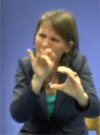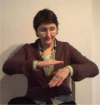Show Me What You've B/Seen: A Brief History of Depiction
- PMID: 35936266
- PMCID: PMC9355279
- DOI: 10.3389/fpsyg.2022.808814
Show Me What You've B/Seen: A Brief History of Depiction
Abstract
Already at a relatively early stage, modern sign language linguistics focused on the representation of (actions, locations, and motions of) referents (1) through the use of the body and its different articulators and (2) through the use of particular handshapes (in combination with an orientation, location, and/or movement). Early terminology for (1) includes role playing, role shifting, and role taking and for (2) classifier constructions/predicates and verbs of motion and location. More recently, however, new terms, including enactment and constructed action for (1) and depicting signs for (2) have been introduced. This article provides a brief overview of the history of enactment and depiction in the sign linguistic literature but mainly focuses on issues related to terminology (and terminology shifts). First, we consider the relation between role shifting and constructed action. We question the idea that these terms can be used interchangeably and rather suggest that they capture different, but related functions. Subsequently, we zoom in on the conceptualization of depicting signs, indicating verbs, pointing signs and fully lexical signs and the relation between these signs and the method of depicting. Where earlier research often associates depicting with the use of specific types of structures, we promote the idea that depicting is a semiotic diverse practice. In doing so, we show that the conceptualization of the different sign types and the terms that are used to refer to these phenomena do not accurately capture the way these signs are used in actual signed discourse and propose a reconceptualization of the different sign types in the lexico-grammar of Flemish Sign Language (VGT) as composite signs that can describe, depict and indicate meaning in various ways. In this way, this article illustrates (1) the risks that may come with the execution of terminology shifts and (2) the importance of making a clear distinction between form and function, i.e., we show that it is important to be careful with assuming a (too) exclusive relation between a certain function and one or more particular forms.
Keywords: classifier constructions; constructed action; depicting sign; depiction; role shifting; semiotics.
Copyright © 2022 Beukeleers and Vermeerbergen.
Conflict of interest statement
The authors declare that the research was conducted in the absence of any commercial or financial relationships that could be construed as a potential conflict of interest.
Figures

















Similar articles
-
Kinect-ing the Dots: Using Motion-Capture Technology to Distinguish Sign Language Linguistic From Gestural Expressions.Lang Speech. 2024 Mar;67(1):255-276. doi: 10.1177/00238309231169502. Epub 2023 Jun 14. Lang Speech. 2024. PMID: 37313985
-
Creating Images With the Stroke of a Hand: Depiction of Size and Shape in Sign Language.Front Psychol. 2018 Jul 31;9:1276. doi: 10.3389/fpsyg.2018.01276. eCollection 2018. Front Psychol. 2018. PMID: 30108532 Free PMC article.
-
Psycholinguistic mechanisms of classifier processing in sign language.J Exp Psychol Learn Mem Cogn. 2021 Jun;47(6):998-1011. doi: 10.1037/xlm0000958. Epub 2020 Nov 19. J Exp Psychol Learn Mem Cogn. 2021. PMID: 33211523 Free PMC article.
-
Making Referents Seen and Heard Across Signed and Spoken Languages: Documenting and Interpreting Cross-Modal Differences in the Use of Enactment.Front Psychol. 2022 Jul 22;13:784339. doi: 10.3389/fpsyg.2022.784339. eCollection 2022. Front Psychol. 2022. PMID: 35936324 Free PMC article. Review.
-
A Usage-Based Proposal for Argument Structure of Directional Verbs in American Sign Language.Front Psychol. 2022 May 17;13:808493. doi: 10.3389/fpsyg.2022.808493. eCollection 2022. Front Psychol. 2022. PMID: 35664145 Free PMC article. Review.
Cited by
-
Mocking enactments: a case study of multimodal stance-stacking.Front Psychol. 2024 Apr 2;15:1379593. doi: 10.3389/fpsyg.2024.1379593. eCollection 2024. Front Psychol. 2024. PMID: 38629031 Free PMC article.
References
-
- Bendixen B. (1975). Eye Behaviors Functioning in American. Sign Language. San Diego: Salk Institute and University of California.
-
- Beukeleers I. (2020). On the Role of Eye Gaze in Flemish Sign Language: a Multifocal Eye-Tracking Study on the Phenomena of Online Turn Processing and Depicting. Ph. D. thesis. Leuven: University of Leuven.
-
- Beukeleers I., Vermeerbergen M. (2017). Raumnutzung in der Flämischen gebärdensprache: eine vergleichende studie zum einfluss des elizitierungsmaterials. Das Zeichen 107 468–477.
-
- Boers-Visker E. (2020). Learning to use Space. A study into the SL2 Acquisition Process of Adult Learners of Sign Language of the Netherlands. Ph. D. thesis. Amsterdam: LOT.
-
- Bos H. (1990). “Person and Location Marking in Sign Language of the Netherlands: Some implications of a Spatially Expressed Syntactic System,” in Current Trends in European Sign Language Research: Proceedings of the Third European Congress on Sign Language Research, eds Prillwitz S., Vollhaber T. (Hamburg: Signum Verlag; ), 231–246.
Publication types
LinkOut - more resources
Full Text Sources

